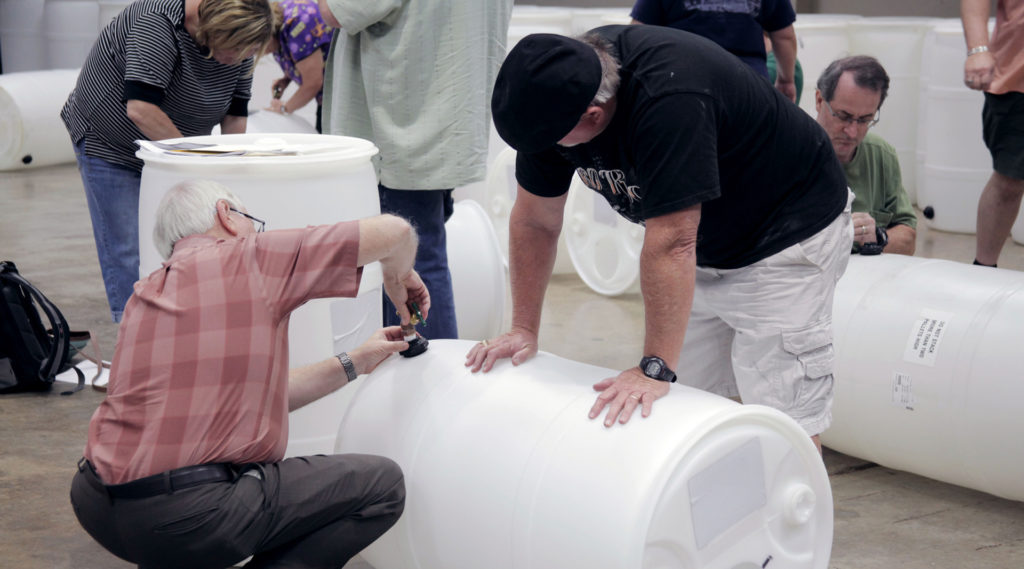Rainwater harvesting tips for beginners
Texas A&M AgriLife horticulturist shares pro tips for saving ‘from’ a rainy day
Any Texan can collect rainwater and save it to use for all non-potable household water needs, increasing water-use efficiency around the home.

“Plus, rainwater is superb for plants,” said Daniel Cunningham, Texas A&M AgriLife Research horticulturist, Dallas. “It’s salt-free, chlorine-free, calcium-free and lime-free, and its pH level is slightly below 7 — making it ideal for the landscape.”
Other uses for harvested rainwater include filling birdbaths, watering concrete foundations, watering houseplants, washing cars, supplementing ponds and pools, and filling aquariums and terrariums.
Cunningham offered a few professional tips, as well as a free digital guide, to help anyone begin saving “from” a rainy day with a homemade rainwater harvesting system.
The rain barrel: A simple solution for catching and storing
A rain barrel is easy to construct from a plastic food-grade drum, Cunningham said.
“Your local food or drink distributor might sell you a barrel,” he said. “Sometimes you can find them in online swap meets through social media and other selling platforms, but it’s important make sure they only previously stored food.
“Avoid barrels that once held petroleum products or soaps,” he said.
The rainwater harvesting guide from AgriLife Research’s Water University public outreach program teaches Texans to convert their food-grade barrels. The guide provides detailed steps for considering parts and tools, sizing, assembly techniques and shielding against mosquitoes. It also offers a series of tips for attaining desired water pressure, linking multiple barrels, dealing with algae, considering overflow and decorating your barrel.
The guide also shares options for diverting water into a barrel.
The roof: A catchment area you already have

To prevent standing water on top of buildings, most Texas roofing aims to efficiently send rainwater to the ground.
“The easiest way to begin collecting rainwater is to look for areas where it naturally flows off the roof,” Cunningham said. “That’s where you’ll want to set up your storage system — the rain barrel or even a larger cistern.”
Areas under the roof where two planes create a valley; sections that have an existing gutter and downspout; and even flat planes with steep inclines and no guttering can all be used to catch rainwater.
For example, a residential rainwater harvesting demonstration at the Texas A&M AgriLife Center, Dallas, consists of a simple decorative chain hung from a roof’s edge, diverting water into a converted food-grade barrel below. This setup can help easily catch runoff from a roof with no gutter system.
But with well-focused rainwater diversion, Cunningham said, a 1-inch rain event can produce a little over half a gallon of harvested rainwater per square foot of roof.
“That may not seem like a lot a first, but if you have 2,000 square feet of roof, you could potentially harvest over 1,000 gallons in one storm.”
How much a barrel can water
“Most homes in Texas can fill several 55-gallon rain barrels in a single rain,” Cunningham said.
As a rule of thumb, a full 55-gallon rain barrel can irrigate a 10-by-10-foot area to a depth of about 5-8 inches. Those estimates pertain to heavy clay soils prevalent across much of Texas.
“But so many factors determine just how far your rainwater can go,” Cunningham said.
Examples include: sunlight, site-specific soil conditions, slope of the terrain and adaptability of existing plants to their natural environments.

“These will all dictate the effectiveness of your harvested rainwater,” he said. “People can also use an inexpensive soil moisture meter to help dictate when plants need water.”
In North Texas, Water University offers its $50 Saving From A Rainy Day program online. The group provides the barrels, tools and hardware, and they guide participants through assembly and usage. Another iteration of the program, which does not provide materials, is free online.
Rainwater harvesting quick tips
- Make rain barrels out of food-grade barrels to help keep harvested water clean.
- Avoid containers that once held petroleum or soap.
- Modify an existing downspout to divert water into your rain barrel.
- For a roof with no gutters, position your barrel under the valley of the roof, where two sloped planes meet
- Use a decorative “rain chain” to get water into your barrel.
- Try harvested rainwater for any non-potable application.
- Consider a moisture meter to test watering efficiency in the landscape.
- Read the Texas A&M AgriLife Water University rainwater harvesting guide.


